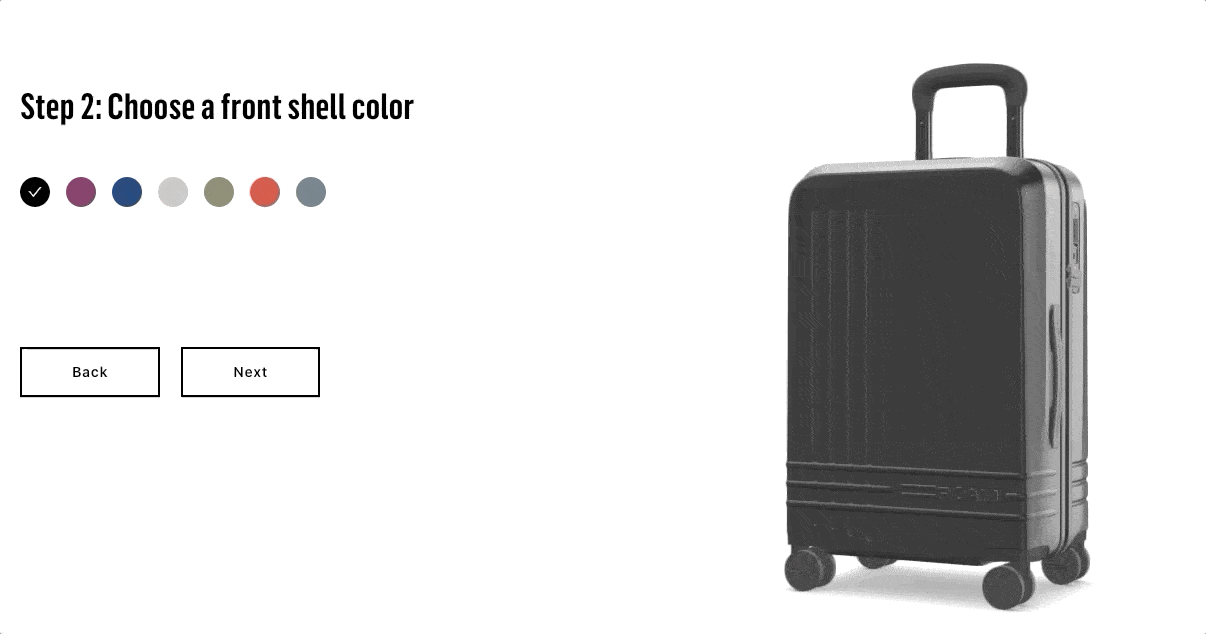5 KPIs Manufacturers Can Improve Immediately With AI Discovery & Selling Tools
AI discovery and guided selling tools deliver immediate, measurable improvements across five retail metrics. Conversion rates can increase through personalized product recommendations and intelligent guidance, and average order value can grow when AI suggests relevant upgrades and complementary products. Cart abandonment rates drop dramatically as AI reduces friction and builds purchase confidence. Return rates decrease when customers receive better product guidance and visualization. Finally, customer engagement time increases substantially, creating more opportunities for sales while building brand loyalty.
Every retailer obsesses over metrics. Conversion rates, average order values, cart abandonment, returns, engagement. These numbers define success or failure in eCommerce. We track them, run A/B tests to improve them, and strategize to move the needle even a few percentage points.
But what if instead of incremental improvements, you could see dramatic gains across multiple KPIs simultaneously? Not over months or years, but within weeks of implementation? That's the promise of AI discovery and guided selling tools, and it's not empty hype. The data from retailers already using these technologies shows transformative results that would be difficult to achieve through traditional optimization methods alone.
According to Grand View Research, the artificial intelligence in the retail market has exploded to $11.61 billion in 2024, projected to reach $40.74 billion by 2030. This massive investment is happening because retailers are seeing real, immediate returns. Many eCommerce professionals now use AI daily, and they're doing it because the impact on key performance indicators is undeniable.
Let's examine five KPIs that AI discovery and selling tools improve immediately, why these improvements happen, and what the real numbers look like.
KPI #1: Conversion Rate – Turning Browsers Into Buyers
Conversion rate might be the most scrutinized metric in all of eCommerce. It's simple, direct, and brutally honest about whether your site is actually working. According to Oberlo, the average eCommerce conversion rate hovers around 2-3%, meaning 97-98 customers out of every 100 leave without buying. That's a lot of wasted traffic, wasted ad spend and wasted opportunity.

AI discovery and guided selling solve this problem from multiple angles. First, AI-powered product recommendations help customers see items relevant to their needs and preferences. When someone arrives looking for running shoes, intelligent discovery systems do more than show a generic grid of footwear; they analyze that customer's browsing patterns, previous purchases, fit preferences, and even contextual signals to surface the most relevant options first.
The numbers speak for themselves: product recommendations can increase conversions by up to 150%, according to Forrester and Gartner. That's not a typo. Some retailers implementing sophisticated AI recommendation engines have more than doubled their conversion rates. According to a study by Slazinger, a sportswear brand using personalized omnichannel messaging and AI-powered automation achieved a 49x ROI and a 700% increase in customer acquisition.
But why such dramatic improvements? The answer lies in reducing friction and decision fatigue. When customers are faced with endless options and lack guidance, they often abandon their search entirely. It's paradoxical but true. Too much choice becomes overwhelming and leads to no choice at all. AI solves this by curating the experience, showing customers what they actually want to see rather than everything that exists.
Guided selling takes this further by helping customers with purchase decisions. For products with multiple configurations, specifications, or use cases, guided selling AI asks intelligent questions to narrow options. Someone buying a laptop doesn't need to understand every technical specification; they need to know the necessary usage patterns, and the AI can find them the right configuration recommendations.
At Threekit, we've observed that conversion improvements accelerate when discovery and guided selling work together. Discovery brings customers to relevant products, and guided selling helps them configure or select the perfect option. This one-two punch creates a seamless path from browsing to buying.
KPI #2: Average Order Value (AOV) – Maximizing Each Transaction
While conversion rate measures how many people buy, average order value measures how much they spend. Both matter to revenue and profitability. The good news is that AI enhances both.
Global eCommerce data from Oberlo shows the average order value reached $144.57 as of November 2024, marking an 8.7% annual increase. But retailers using AI discovery and guided selling are seeing much larger AOV improvements than the market average. Product recommendations can increase average order value by 50%, and AI-driven personalization delivers even stronger results.
How does this work in practice? AI identifies optimal upselling and cross-selling opportunities based on what each specific customer is likely to value. Instead of generic "customers also bought" suggestions, AI analyzes purchase patterns, product compatibility, and customer behavior to recommend upgrades or additions that genuinely make sense.
For example, someone buying a premium camera is photography-focused. Rather than suggesting random accessories, the AI recognizes this customer's commitment level and recommends professional-grade memory cards, a quality camera bag, and perhaps a versatile lens. These aren't random add-ons; they're logical additions that enhance the primary purchase.
Forbes reports that 40% of US consumers say a personalized customer experience led them to make a more expensive purchase than originally planned. When AI provides relevant suggestions for upgrades or premium features, customers don't feel pressured; they feel helped. There's a psychological difference between upselling and guidance.
Guided selling specifically excels at driving AOV for configurable products. When customers are building custom solutions, including furniture, technology, and business equipment, the AI can suggest premium materials, extended warranties, or feature upgrades that align with their stated needs and preferences. Because these recommendations come through the natural flow of the guided selling conversation, they feel like helpful advice rather than sales tactics.
Personalized on-site product recommendations constitute 11.5% of revenue through eCommerce sites (Marketing Sherpa). That's a massive chunk of total revenue directly attributable to intelligent recommendation systems. Brands utilizing first-party data in key marketing functions achieved a 2.9-times increase in revenue lift, demonstrating how powerful personalized AI tools can be when properly implemented (CMS Newswire).

One particularly effective strategy is threshold-based recommendations. The AI identifies customers approaching certain spending levels and strategically suggests items that push them over the threshold for free shipping or other incentives. This isn't manipulative when done right. It's providing value by helping customers optimize their purchases to get the benefits they actually want.
KPI #3: Cart Abandonment Rate – Recovering Lost Sales
Cart abandonment is the silent killer of online revenue. Baymard reports that the average cart abandonment rate sits at 70.22%, meaning seven out of every ten customers who add items to their cart leave without purchasing. That's $18 billion in lost sales annually across the industry, with the projected yearly value of abandoned merchandise reaching around $4 trillion (Sellers Commerce).
These numbers are staggering, representing one of the biggest opportunities for immediate improvement through AI. Many abandonments occur when customers encounter friction points, such as unexpected costs, complicated checkout, uncertainty about their choice, or simply getting distracted. AI discovery and guided selling address several of these root causes directly.
First, AI reduces purchase uncertainty, which is a major abandonment driver. When customers lack confidence in their decision, they often back out at the last minute. Guided selling builds that confidence by validating their selection through intelligent questions and reassurance. Product visualization (which often integrates with guided selling) lets them see exactly what they're getting, removing the "what if it doesn't look right?" doubt.
Second, AI-powered chatbots and virtual assistants can intervene at the moment of abandonment. When the system detects hesitation, prolonged time on the cart page, movement toward the exit button, or other signals, an AI assistant can offer help. Not in an annoying pop-up way, but in a genuinely helpful "Do you have questions?" approach.
48% of online shoppers abandon their carts due to extra costs like shipping. AI can't eliminate shipping costs, but it can help customers understand them earlier in the journey and suggest ways to qualify for free shipping by adding items that would benefit their purchase anyway. This approach transforms a negative surprise into a positive opportunity.
Retailers using AI-powered fit and sizing tools have seen cart abandonment related to fit uncertainty drop dramatically. Uncertainty around fit contributes to approximately 73% of cart abandons, but when AI helps customers find the right size or see how products will actually look, this hesitation evaporates.
The recovery potential here is enormous. According to Baymard, improving checkout flow and design could recover lost orders worth $260 billion. While not all of that comes from AI, intelligent systems that reduce friction, build confidence, and provide timely assistance capture a significant portion of these otherwise-lost sales.
We've seen retailers reduce cart abandonment by 15-20 percentage points after implementing comprehensive AI discovery and guided selling systems. On high-traffic sites, that translates to thousands of additional completed purchases monthly, purchases that were already 90% of the way to happening but fell apart at the last moment.
KPI #4: Return Rate – Reducing Costly Product Returns
Product returns are expensive, frustrating, and increasingly problematic for retailers. According to the National Retail Federation, the average return rate for eCommerce was 16.9% in 2024, with total returns projected to reach $890 billion. That's not just lost revenue. It's also the cost of reverse logistics, restocking, depreciation, and often the inability to resell items at full price.
Returns often indicate failed customer experiences. Someone who returns a product is typically disappointed, and disappointed customers rarely become loyal advocates. Opensend research suggests return rates for online purchases reach 20-30%, compared to just 8.89% for in-store purchases. The difference? In physical stores, customers can see, touch, and try products before buying.
AI discovery and guided selling help bridge this gap. When customers receive intelligent guidance about which products actually suit their needs, they're far less likely to experience buyer's remorse.
The mechanism here is straightforward: better product-customer matching leads to fewer disappointed customers. If someone primarily needs a laptop for video editing, and the AI-guided selling process recommends a machine with suitable graphics capabilities and processing power, the customer receives a product that meets their needs. They don't end up returning it because it can't handle their workload.
For apparel and footwear, categories with notoriously high return rates, AI-powered fit and sizing tools make a massive difference. Approximately 70% of online apparel returns stem from poor fit, according to McKinsey. When AI helps customers order the right size the first time, those returns simply don't happen.
Product visualization, often integrated with guided selling, also plays a role here. When customers can see accurate representations of products, including how they'll look in their space or on their body, expectations align with reality. The "it looked different online" returns drop dramatically when customers can view products from every angle, in different colors, or placed virtually in their environment.
At Threekit, we've developed visualization tools specifically designed to reduce return rates by giving customers confidence before purchase. When someone can see exactly how a configured product will look, place furniture virtually in their room, or view apparel in different sizes and styles, they make better decisions that they're less likely to regret.
The financial impact of reducing returns extends beyond just the return costs themselves. Lower return rates improve inventory management, reduce logistics complexity, lower environmental impact, and most importantly, create satisfied customers who are more likely to purchase again. Retailers who successfully reduce returns through AI aren't just saving money on reverse logistics. They're building stronger customer relationships.
KPI #5: Customer Engagement Time – Keeping Shoppers Involved
While not always tracked as religiously as conversion or AOV, customer engagement time is a leading indicator for sales. Customers who spend more time actively engaging with products, configurators, and content are far more likely to purchase than those who bounce quickly. They're also more likely to develop emotional connections to products and brands, which drives long-term loyalty.

AI discovery and guided selling significantly increase engagement time, but in a positive way. This isn't about tricking customers into staying on site longer. It's about creating genuinely engaging experiences that customers want to spend time with because they're valuable and interesting.
Interactive guided selling experiences naturally extend engagement. When customers answer questions, see personalized recommendations, and configure products to their preferences, they're actively participating rather than passively scrolling. This active involvement creates investment in the process and outcome. People who spend ten minutes carefully configuring a product with AI guidance have a much higher emotional stake in completing the purchase than someone who spends thirty seconds glancing at a static product page.
Product visualization and configurators particularly drive engagement. Customers love playing with 3D product viewers, where they can rotate items to see every angle, change colors and materials in real-time, and experiment with different configurations. At Threekit, we've seen customers spend 5-10 minutes engaging with well-designed product configurators, far longer than they'd spend viewing static images.
This extended engagement creates multiple benefits. First, it gives the AI more data points to refine its recommendations. Every interaction teaches the system more about that customer's preferences. Second, it builds familiarity and comfort with the product. The more time someone spends examining and configuring an item, the more confident they become in their understanding of it. Third, it creates a sense of investment and ownership even before purchase. When someone has spent time customizing something to their exact preferences, they're psychologically committed to completing the transaction.
AI-powered chatbots and virtual assistants also drive engagement by making the shopping experience conversational and interactive. According to Sellerscommerce, 80% of retail and ecommerce businesses use AI chatbots or plan to use them, and those who implement them effectively see customers spending more time in meaningful interactions.
The key is that this increased engagement correlates directly with business outcomes. McKinsey’s research shows that companies using highly personalized interactions outperform others by 10 to 15% in conversion and revenue. These personalized interactions, driven by AI discovery and guided selling, create the engagement that leads to those improved conversions.
Longer engagement also means more opportunities to present relevant products, answer questions, and build trust. A customer who spends fifteen minutes exploring products and receiving AI guidance has multiple chances to discover items they didn't initially know they wanted. This organic discovery process, facilitated by intelligent AI systems, drives both conversions and higher-order values.
The Compounding Effect: When KPIs Improve Together
What makes AI discovery and guided selling particularly powerful is that these KPI improvements don't happen in isolation; they compound and reinforce each other. Higher engagement leads to better conversions. Better product matching reduces returns while increasing AOV. Lower cart abandonment preserves the gains from improved discovery and guidance.
Consider a customer journey where all five KPIs improve. AI discovery brings them to relevant products quickly (reducing bounce rate and improving early engagement). Guided selling helps them configure the perfect option (increasing engagement time and building purchase confidence). This confidence reduces cart abandonment. A better product match leads to higher customer satisfaction and fewer returns. And throughout the process, intelligent upselling and cross-selling increase the order value.
This compounding effect means the total business impact exceeds the sum of individual metric improvements. A 150% conversion rate increase combined with a 50% AOV increase doesn't just add up; it multiplies. When you're converting more customers and each customer is spending more, the revenue impact is exponential.
Implementation: Making It Happen Quickly
The "immediately" in this article's title is intentional. Unlike some retail initiatives that take months or years to show results, AI discovery and guided selling tools can improve KPIs within weeks of proper implementation. The key is starting with high-quality product data, clear goals, and a willingness to iterate based on performance.
Begin by identifying your biggest pain points. If returns are impacting profitability, prioritize AI tools that enhance product matching and offer improved pre-purchase guidance. If cart abandonment is your problem, focus on reducing friction and building confidence. If AOV is lagging, emphasize intelligent upselling and cross-selling capabilities.
The technology has matured to the point where implementation doesn't require massive custom development. Solutions like those we provide at Threekit integrate with existing eCommerce platforms and can be deployed relatively quickly. The AI models learn and improve continuously, meaning performance actually gets better over time as the system accumulates more data about customer behavior and preferences.
The future of retail belongs to those who embrace these technologies not as experiments but as core capabilities. The KPI improvements are real, the timeline is immediate, and the competitive advantage is substantial. The only question is how quickly you can get started.
Sources:
- Grand View Research - Artificial Intelligence In Retail Market Size Report: https://www.grandviewresearch.com/industry-analysis/ai-retail-market-report
- EComposer - AI in eCommerce Statistics 2025: https://ecomposer.io/blogs/ecommerce/ai-in-ecommerce-statistics
- SellersCommerce - AI In ECommerce Statistics: https://www.sellerscommerce.com/blog/ai-in-ecommerce-statistics/
- Bold Metrics - Strategic AI Investments in Retail 2025: https://blog.boldmetrics.com/strategic-ai-investments-in-retail-2025-balancing-innovation-and-roi
- Insider (Agent One) - AI in Retail 2025 Trends: https://useinsider.com/ai-retail-trends/
- Oberlo - Average Order Value Statistics: https://www.oberlo.com/statistics/average-order-value
- VWO - Using Personalization to Increase AOV: https://vwo.com/blog/personalization-to-increase-aov-and-conversion-rates/
- Omnia Retail - Boosting E-commerce Revenue: https://www.omniaretail.com/blog/unlocking-higher-profits-from-the-same-number-of-customers
- Baymard Institute - Cart Abandonment Rate Statistics: https://baymard.com/lists/cart-abandonment-rate
- Tidio - Shopping Cart Abandonment Statistics: https://www.tidio.com/blog/shopping-cart-abandonment-statistics/
- National Retail Federation - 2024 Retail Returns Report: https://nrf.com/media-center/press-releases/nrf-and-happy-returns-report-2024-retail-returns-total-890-billion
- Shopify - Ecommerce Returns Guide: https://www.shopify.com/enterprise/blog/ecommerce-returns
- IHL Group via Statista - AI and ML Impact on Retail Performance: https://www.statista.com/statistics/1453198/ai-and-ml-impact-on-retail-performance/
- All About AI - AI Agents Statistics: https://www.allaboutai.com/ai-agents/statistics/
- Marketing Sherpa - eCommerce chart https://marketingsherpa.com/article/chart/personalized-product-recommendations
- Opensend - https://www.opensend.com/post/return-refund-rate-ecommerce#:~:text=reduce%20unnecessary%20returns.-,1)%20Average%20ecommerce%20return%20rate%20ranges%20between%2020%25%20and%2030,rates%20may%20climb%20even%20higher.


